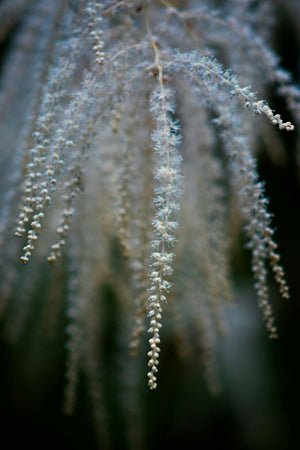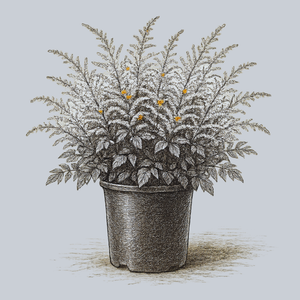The Aruncus Guide
Aruncus, commonly known as Goat’s Beard, is a hardy perennial prized for its feathery plumes of creamy-white flowers and lush, fern-like foliage. A member of the Rosaceae family, Aruncus thrives in moist, shaded areas, making it an excellent choice for woodland gardens, borders, and naturalized plantings. With its impressive height and textural beauty, this plant provides long-lasting interest throughout the growing season. Here’s everything you need to know about growing and caring for Aruncus.

About
Aruncus is a genus of herbaceous perennials native to temperate regions of North America, Europe, and Asia. It is often compared to Astilbe due to its similar feathery flower plumes, though Aruncus tends to be larger and more robust. The plant’s deep green foliage remains attractive throughout the season, and its tall, airy blooms attract pollinators such as bees and butterflies.
Popular varieties include Aruncus dioicus, a tall and stately species reaching up to 6 feet in height; Aruncus aethusifolius, a dwarf variety ideal for smaller spaces; and hybrids like Aruncus 'Misty Lace' and Aruncus 'Chantilly Lace', which offer more compact growth while maintaining the elegant floral display. Aruncus 'Fairy Hair', with its finely dissected foliage, adds unique texture to shaded gardens.
Aruncus is a deer-resistant plant that thrives in moist, well-drained soil with partial shade. It is a long-lived perennial that requires minimal maintenance once established, making it a reliable choice for gardeners seeking structure and elegance in shaded landscapes.

PLANTING
- USDA Hardiness Zones: Most Aruncus varieties thrive in Zones 3-8, offering excellent cold tolerance.
- Soil: Prefers rich, moist, well-drained soil. Adding compost improves soil fertility and water retention.
- Sunlight: Grows best in partial shade but can tolerate full sun with consistent moisture.
- Watering: Requires regular watering, particularly in dry conditions. Soil should remain consistently moist but not waterlogged.
- Spacing: Space plants 18-36 inches apart, depending on the variety, to allow for mature growth and airflow.
- Planting Time: Best planted in early spring or fall when temperatures are mild and soil moisture is stable.
To plant Aruncus, dig a hole slightly larger than the root ball, place the plant at the same depth as it was in its container, and backfill with soil. Water thoroughly after planting to encourage root establishment.

CARE
- Watering: Maintain evenly moist soil, especially in hot or dry weather. Mulching around the base of the plant helps retain moisture.
- Fertilizing: Apply a balanced, slow-release fertilizer or compost in early spring to promote healthy growth.
- Pruning: Remove spent flower stalks after blooming to maintain a tidy appearance. Cut back dead foliage in late fall or early spring to encourage fresh growth.
- Pests & Diseases: Generally pest-resistant, but may develop powdery mildew or rust in humid conditions. Good air circulation helps prevent fungal issues.
- Dividing: Divide mature clumps every 4-5 years in early spring or fall to rejuvenate plants and promote vigorous growth.

HOW TO USE
Aruncus’s bold foliage and elegant plumes make it a valuable addition to many garden styles:
- Woodland Gardens: Thrives in dappled shade alongside ferns, hostas, and astilbes.
- Pollinator Gardens: Attracts bees, butterflies, and beneficial insects with its nectar-rich blooms.
- Borders & Backdrops: Taller varieties like Aruncus dioicus provide structure in mixed perennial borders.
- Moisture-Rich Areas: Ideal for rain gardens and pondside plantings where consistent moisture is available.
- Compact Gardens: Dwarf varieties such as Aruncus aethusifolius work well in small spaces and container plantings.

Common Questions
- How to care for Aruncus? Provide rich, moist soil, partial shade, and regular watering. Prune spent flower stalks and cut back foliage in fall or early spring.
- How to tell Astilbe from Aruncus? Aruncus has larger, coarser foliage, grows taller, and tends to have a more open, airy bloom structure compared to the dense, feathery plumes of Astilbe.
- Is Aruncus deer resistant? Yes, Aruncus is highly deer-resistant due to its coarse foliage and bitter taste.
- What does Aruncus dioicus look like in the winter? In winter, Aruncus dioicus dies back to the ground, leaving behind dried flower stalks that can be cut back for a tidier appearance.
- When to divide Aruncus? Divide in early spring or fall every 4-5 years to maintain plant vigor and prevent overcrowding.
Conclusion
Aruncus is a hardy, low-maintenance perennial that brings elegant texture and seasonal interest to shaded gardens. Whether planted as a tall border backdrop, in a woodland setting, or along moisture-rich garden edges, Goat’s Beard adds structure and charm to the landscape. With selections like Aruncus dioicus, Aruncus 'Misty Lace', and Aruncus 'Fairy Hair', there is an Aruncus variety suited for every garden. Explore our collection and enhance your garden with the beauty of Aruncus.
The Aruncus Collection
Sold Out
Sold Out






